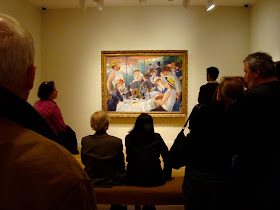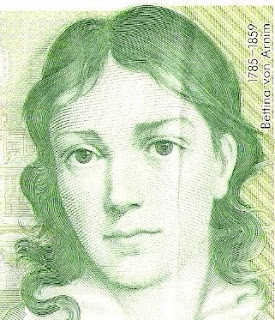
Now to what Rüdiger Safranski
writes about Schiller's Wilhelm Tell. After finishing
The Bride from Messina, which was "administered to the public like a strong dose of medicine" (I have seen the play, and it does feel like medicine), Schiller got seriously down to work in the spring of 1802 and finished a draft of his mountain play in August 1803. He wrote to Goethe in November that he was not letting himself get distracted by anything and predicted finishing it by March. He even thought of traveling to Switzerland, to visit the places associated with the Tell legend, but his health did not permit it. In any case, he felt that his own imagination and Goethe's account had made him familiar with the "
Genius loci." As with an earlier play,
Wallenstein, Schiller worked closely with Goethe, who was eager for a new play for the Weimar stage.
While Schiller was writing, Switzerland itself was in the process of losing its celebrated independence. Napoleon "liberated" the Swiss people, whose system of independent cantons was regarded as feudal, and proclaimed the Helvetic Republic in April 1798. Resistance to the French was particularly strong in the "Ur" cantons of Uri, Schwyz, and Nidwalden, the original partners in the oath on the
Rütli meadow of 1291 (portrayed here in Heinrich Füssli's 1780 painting), which marked the beginnings of the Swiss Confederacy.

By swearing an oath, the Swiss had formed an alliance to protect their freedoms from would-be overlords. The memory of this earlier heroic period inspired their resistance to the French in the late 18th century.
By 1799 Switzerland had become a battleground featuring French, Austrian, and Russian armies. In Germany, too, the desire for freedom from French hegemony began to stir the natives. This desire would culminate a decade later in the
wars of liberation against Napoleon. And, as in Switzerland, the voice of resistance appealed to incipient "German" traditions.
The resistance to tyranny in Schiller's play is portrayed as a conservative revolution. According to Safranski, Schiller abandoned his earlier vision of a new human being that would become capable of freedom through the process of aesthetic education. Instead, Schiller discovered revolutionary potential in the past, in the mountain world of Wilhelm Tell. The true revolution does not owe its existence to a "new man," as in
The Aesthetic Letters," but in the defense of what has worked well in the past (
Verteidigung des alten, wohlgeratenen). "Great deeds occur when what has proved itself takes up arms against bad reform" (
Großes entsteht, wenn das Bewährte sich wehrt gegen eine schlechte Neuerung). In Schiller's drama, Wilhelm Tell defends an ancient, natural freedom of men against tyranny.
Schiller re-creates the original alliance, in a "cyclical drama." A community, in the course of its fight against tyranny, establishes a "covenant" (Bund) that reproduces what is originally a product of nature (naturwüchsig). The new, strengthened covenant is the outcome of an historical act. The community has been disturbed in its natural idyll by being cast into history, but in the end people return, richer in experience, to their idyllic origin.
Who acts? The community, yes, but above all Wilhelm Tell, who belongs to the community but also remains aloof from it. Thus, he does not take part in the oath on the Rütli meadow: "The strong man is most powerful when acting alone," he declares. When he kills Gessler, he is acting without a mandate; the responsibility is his alone. While triggering the collective freedom. he keeps the process from becoming all too political, from descending into strategic calculation. Safranski calls him a "self-helper."
The cyclical movement of the play applies to Tell himself. After killing Gessler, after the bloody excursion into history, he also returns home to the idyll. The same fire burns in the hearth, wife and children await him, the patriarchal world still stands, but Tell is no longer the same. By murdering the tyrant, he has lost his innocence.
Schiller, continues Safranski, was eager to absolve Tell of the crime of murder. In the last scene, a figure dressed as a monk appears at Tell's house. He is really Johannes Parricida, a duke of Swabia, who has murdered the emperor, his own uncle. Since the emperor has deprived him of his patrimony, he imagines Tell will be sympathetic: "You have slain the Governor who did you wrong. I too have slain a foe who robbed me of my rights. He was no less your enemy than mine. I've rid the land of him."

Tell will have none of this: "Dare you confound the crime of blood-imbrued ambition with the act forced on a father in mere self-defense. Had you to shield your children's darling heads, to guard your fireside's sanctuary - ward off the last, the direst doom from all you loved? ... You murdered, I have shielded all that was most dear to me." Schiller thus portrays Tell's act in the republican tradition of Brutus. As a side note, John Wilkes Booth, who assassinated Abraham Lincoln, defended his act with reference to Wilhelm Tell. Responding to the revulsion of contemporaries at Lincoln's murder, Wilkes wrote that he was only "doing what Brutus was honored for and what made Tell a Hero." Interestingly, the Helvetic Republic also sought to make use of the Wilhelm Tell legend by featuring the archer's image on its official seal.
Goethe was disturbed about one murderer blaming another murderer. As Safranski writes, Goethe would presumably have made his own "Wilhelm Tell" darker and more contradictory, but, when the play premiered in Weimar on March 17, 1804, he professed himself satisfied.

























